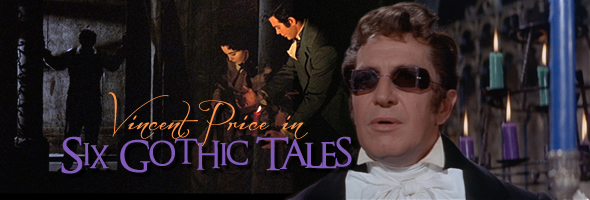
THE FALL OF THE HOUSE OF USHER
Color, 1960, 79m.
Directed by Roger Corman
Starring Vincent Price, Mark Damon, Myrna Fahey
Arrow (Blu-ray & DVD) (UK RB/R2 HD/PAL), Scream Factory (Blu-ray) (US RA HD), MGM (DVD) (US R1 NTSC) / WS (2.35:1) (16:9)
THE PIT AND THE PENDULUM
Color, 1961, 80m.
Directed by Roger Corman
Starring Vincent Price, John Kerr, Luana Anders, Anthony Carbone, Barbara Steele
Arrow (Blu-ray & DVD) (UK RB/R2 HD/PAL), Scream Factory (Blu-ray) (US RA HD), TGG Direct (DVD) (US R1 NTSC) / WS (2.35:1) (16:9), MGM (DVD) / WS (2.35:1)
TALES OF TERROR
Color, 1962, 89m.
Directed by Roger Corman
Starring Vincent Price, Basil Rathbone, Peter Lorre, Debra Paget, Joyce Jameson, Maggie Pierce, Leona Gage, David Frankham
Arrow (Blu-ray & DVD) (UK RB/R2 HD/PAL), MGM (DVD) (US R1 NTSC) / WS (2.35:1) (16:9)
THE RAVEN
Color, 1963, 86m.
Directed by Roger Corman
Starring Vincent Price, Peter Lorre, Boris Karloff, Hazel Court, Jack Nicholson, Olive Sturgess
Arrow (Blu-ray & DVD) (UK RB/R2 HD/PAL), Scream Factory (Blu-ray) (US RA HD), MGM (DVD) (US R1 NTSC) / WS (2.35:1) (16:9)
THE HAUNTED PALACE
Color, 1963, 87m.
Directed by Roger Corman
Starring Vincent Price, Debra Paget, Lon Chaney Jr.,
Frank Maxwell, Elisa Cook Jr.
Arrow (Blu-ray & DVD) (UK RB/R2 HD/PAL), Scream Factory (Blu-ray) (US RA HD), Koch (Blu-ray & DVD) (Germany RB/R2 HD/PAL), MGM (DVD) (US R1 NTSC) / WS (2.35:1) (16:9)
THE TOMB OF LIGEIA
Color, 1964, 81m.
Directed by Roger Corman
Starring Vincent Price, Elizabeth Sheppard, John Westbrook, Derek Francis
Arrow (Blu-ray & DVD) (UK RB/R2 HD/PAL), Scream Factory (Blu-ray) (US RA HD), MGM (DVD) (US R1 NTSC) / WS (2.35:1) (16:9)
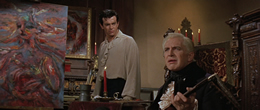 Arguably the greatest multi-film actor/director collaboration in the horror genre came from an unlikely source at the start of the 1960s when producer/director Roger
Arguably the greatest multi-film actor/director collaboration in the horror genre came from an unlikely source at the start of the 1960s when producer/director Roger 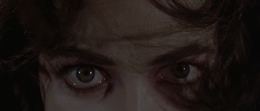 Corman, a resourceful, budget-conscious filmmaker at American-International Pictures, decided to aim for a more prestigious drive-in crowd than usual by mounting a colorful, widescreen adaptation of a (public domain) Edgar Allan Poe tale. For his leading man he made a choice that would define the course of horror for the following decade when he selected Vincent Price, who had just proven his macabre leading man mettle in a pair of hit William Castle films. The result was The Fall of the House of Usher (or, as most prints and marquees simply called it, House of Usher). Surprisingly close to the original Poe story, this was one of the AIP studio's biggest hits at the time and set off a long, fruitful series of Corman/Price gothics, mostly based on other Poe stories.
Corman, a resourceful, budget-conscious filmmaker at American-International Pictures, decided to aim for a more prestigious drive-in crowd than usual by mounting a colorful, widescreen adaptation of a (public domain) Edgar Allan Poe tale. For his leading man he made a choice that would define the course of horror for the following decade when he selected Vincent Price, who had just proven his macabre leading man mettle in a pair of hit William Castle films. The result was The Fall of the House of Usher (or, as most prints and marquees simply called it, House of Usher). Surprisingly close to the original Poe story, this was one of the AIP studio's biggest hits at the time and set off a long, fruitful series of Corman/Price gothics, mostly based on other Poe stories.
Philip Winthrop (Black Sabbath's Mark Damon) arrives at the foggy, foreboding estate of Roderick Usher (Price), a morose, obsessed man whose sister, Madeleine (Fahey), is destined to be Philip's bride. As Roderick explains, the Usher bloodline is cursed, and Madeleine has been afflicted with cataleptic trances which will one day soon prove to be her doom. Philip dismisses Roderick's claims, but then Madeleine seems to pass away and is interred in the family crypt. However, death is hardly the end for poor Madeleine and her possibly mad brother...
Exquisitely mounted on a deceptively low budget, House of Usher is a colorful feast of overripe imagery, slim on plot but heavy on atmosphere. All of the ground rules for further Poe films are clearly laid out here, making this the horror equivalent of Dr. No. Floyd Crosby's expert scope photography, Price's brooding central performance, and Les Baxter's brash, emphatic music all combine for a cinematic experience which proved to be one of the most influential of its decade. While Corman later outdid this one in future entries, House of Usher still holds up extremely well, apart from the hamstrung special effects which render the final nightmarish inferno a tad less convincing than one might hope, even for 1960.
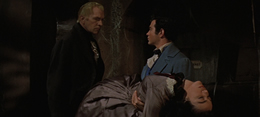 The first widescreen version of Usher on home video arrived on laserdisc from Image Entertainment through Orion, obliterating the horrific pan-and-scan VHS copies and broadcasts that turned the film into a zoomed-in nightmare. An anamorphic MGM DVD in 2001 was even better with a solid transfer for the time along with the US theatrical trailer and a feature-length commentary by Roger Corman, who affectionately recalls the details of getting the film produced under the Nicholson/Arkoff regime of AIP and the methods he used to craft a sumptuous visual appearance with limited resources.
The first widescreen version of Usher on home video arrived on laserdisc from Image Entertainment through Orion, obliterating the horrific pan-and-scan VHS copies and broadcasts that turned the film into a zoomed-in nightmare. An anamorphic MGM DVD in 2001 was even better with a solid transfer for the time along with the US theatrical trailer and a feature-length commentary by Roger Corman, who affectionately recalls the details of getting the film produced under the Nicholson/Arkoff regime of AIP and the methods he used to craft a sumptuous visual appearance with limited resources.
The film hit Blu-ray the exact same year in both the UK and the US in 2013, with the former from Arrow leaping out of the gate by two months in both standard and steelbook editions. That one carries over the Corman commentary and trailer while adding a fun new featurette with Corman disciple Joe Dante (entitled "Legend to Legend" and running a generous 26 minutes), a 32-minute video appraisal of the film by English horror expert Jonathan Rigby, a nifty 10-minute video essay about the film and the source story by David Cairns (entitled "Fragments of the House of Usher"), and an archival interview with Price about his initial collaboration with Corman. Meanwhile in America the film bowed in HD from Scream Factory as part of The Vincent Price Collection, the first of its two sets devoted to the horror star. That edition contains the commentary and trailer plus a 41-minute audio interview with Price about the film and doing Poe adaptations, an image gallery, a second audio commentary with Price biographer Lucy Chase Williams about the actor's career at the time, and a vintage video intro and outro recorded by Price in the '80s for an Iowa PBS television retrospective of his gothic horror films. (These PBS wraparounds are present for all of the other Scream Factory Price/Corman titles, too.) The transfers are very similar for both and come from the same source, with the Arrow nudging out ahead a bit thanks to a higher bit rate; however, the Scream Factory is also a keeper given the inclusion of the original Les Baxter overture, which was excised from most general release prints.
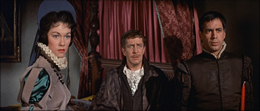 After the tremendous success of Usher, it didn't
After the tremendous success of Usher, it didn't 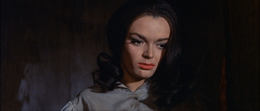 take long to churn out a second title in less than a year. Usher writer Richard Matheson (The Incredible Shrinking Man) was retained to pen The Pit and the Pendulum, a delicious popcorn muncher of the highest order and a far pulpier escapade in every respect. Vincent Price has a field day alternating from gibbering terror to teeth-gnashing insanity (sometimes in the same scene) and wiping all but one of his co-stars off the screen as Nicholas Medina, a nobleman tormented by the inexplicable death of his bride, Elizabeth (Black Sunday's Steele, who nearly swipes the film in just a few minutes of screen time). Trouble starts when Elizabeth's petulant brother, Francis (Kerr), rides up on horseback demanding an explanation for her demise, which seems to be connected to the Medina castle's horrific past involving torture, infidelity, murder, and madness. Meanwhile Nicholas's sister, Catherine (Dementia 13's Anders) and the family doctor (Carbone) try to keep the peace as a ghost seems to stalk the hallways and Nicholas's sanity unravels at a frightening pace.
take long to churn out a second title in less than a year. Usher writer Richard Matheson (The Incredible Shrinking Man) was retained to pen The Pit and the Pendulum, a delicious popcorn muncher of the highest order and a far pulpier escapade in every respect. Vincent Price has a field day alternating from gibbering terror to teeth-gnashing insanity (sometimes in the same scene) and wiping all but one of his co-stars off the screen as Nicholas Medina, a nobleman tormented by the inexplicable death of his bride, Elizabeth (Black Sunday's Steele, who nearly swipes the film in just a few minutes of screen time). Trouble starts when Elizabeth's petulant brother, Francis (Kerr), rides up on horseback demanding an explanation for her demise, which seems to be connected to the Medina castle's horrific past involving torture, infidelity, murder, and madness. Meanwhile Nicholas's sister, Catherine (Dementia 13's Anders) and the family doctor (Carbone) try to keep the peace as a ghost seems to stalk the hallways and Nicholas's sanity unravels at a frightening pace.
Arguably the best gateway film to get newcomers into the Poe cycle, 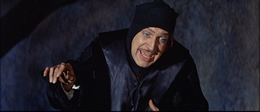 Pit moves at a quick pace through all of the gothic trappings including psychedelic flashbacks, dark family secrets, premature burial, and a barnstorming climax complete with one of the greatest shock ending images in the genre's history. Matheson's script has a few issues, namely some overwritten dialogue and a very awkward contrivance to get a poor sap under that swinging pendulum, but it's so much fun you'll barely even notice.
Pit moves at a quick pace through all of the gothic trappings including psychedelic flashbacks, dark family secrets, premature burial, and a barnstorming climax complete with one of the greatest shock ending images in the genre's history. Matheson's script has a few issues, namely some overwritten dialogue and a very awkward contrivance to get a poor sap under that swinging pendulum, but it's so much fun you'll barely even notice.
Perhaps no film fared worse than this one back in the pan and scan days of '80s VHS releases, with the very wide, carefully composed images seen here hacked into an incoherent, blurry mess. The first widescreen edition of this film appeared back in the laserdisc days from Image through Orion, and that same non-anamorphic transfer was carried over for a well-intentioned but flawed DVD from MGM in 2001 as part of its Midnite Movies line, in which Corman appears for a commentary track discussing the tactics used to follow up the hit first film so quickly and how an entirely new narrative was generated out of a story that lasts all of about three pages. The disc also includes the original theatrical trailer and, in an unexpected coup, the video premiere of a four minute prologue shot for the original TV broadcast which finds Anders suffering inside an asylum following the events of the film. The prologue is in perfect condition, and it's a fascinating bonus from a time when such additional scenes were far for the course in drive-in film making.
The film was later given an anamorphic (but interlaced) upgrade by TGG Direct as part of a three-film Price/Poe set in 2011, which was soon eclipsed in 2013 by Scream Factory's lavish, essential Blu-ray set, The Vincent Price Collection. Packaged alongside five other Price AIP films, that disc features a tremendously improved HD rendering of the film along with the Corman commentary, prologue, and trailer, plus a stills gallery and 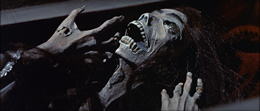 what remains an exclusive to the set, a great Price intro and outro for the film originally recorded for a public
what remains an exclusive to the set, a great Price intro and outro for the film originally recorded for a public 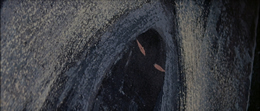 television broadcast series of his most notable titles.
television broadcast series of his most notable titles.
Meanwhile Arrow continued its Poe/Price/Corman run with standard and steelbook Blu-rays of this film in 2014, and the feature benefits from getting an entire disc to itself (compared to the American one, which paired it on the same platter with Masque of the Red Death). Generally they look similar, though the uptick in compression space results in a more satisfying technical presentation overall with a slightly less digital veneer. The Corman commentary, trailer, and prologue are here once again, but a slew of new additions make this more than a little tempting. The score by Les Baxter (his only Poe one never given a soundtrack release of any kind) is included here as an isolated music and effects track, and a new second audio commentary by Video Watchdog's Tim Lucas covers the film's history in minute detail from casting to production design. He also makes a number of observations about the film's unusual aesthetic and draws together recurring motifs from the entire Corman/Poe cannon (and only one little slip early on with a key Amicus horror anthology title). His brief Harvard/Yale speculation is a keeper, too. Then there's the 43-minute "Behind the Swinging Blade," a great new featurette with new interviews with Corman, Steele, Victoria Price, director Brian Yuzna, and (briefly) David Del Valle about the film's creation, with an understandably strong focus on Price and his joy with working with young artists at the time. Corman repeats a fair amount of info from his commentary but he's always a charming presence, and it's always a rare treat to have the amazing Steele remarking on her horror career in any form. Finally you get the 53-minute "An Evening with Edgar Allan Poe" TV special, in which Price enthusiastically delivers a quartet of classic short stories (shot on videotape and from the same iffy master seen on MGM's previous DVD) and an illustrated booklet including liner notes by Jonathan Rigby.
Arrow's discs of Pit and Usher are also included in the label's 2014 Blu-ray boxed set, Vincent Price in Six Gothic Horrors, which also includes four additional titles (with separate releases timed to coincide with it to avoid double dipping). However, fans will still find the Price set well worth the investment as it includes a hefty 200-page book with a slew of essays, Vincent Price biography selections, and best of all, full reproductions of the original comic books created to promote three of the titles (Tales of Terror, The Raven, The Tomb of Ligeia). All but one of the films are available in the US via Scream Factory's Price sets, but the virtual lack of overlap with the extras and some variations between the transfers also make the set a dream come true for classic horror fans. Which brings us to the next chronological film in the box...
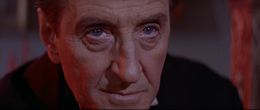 After striking gold, Roger Corman decided to tweak the formula a bit by presenting Poe's short stories as three vignettes rather than dragging a slim
After striking gold, Roger Corman decided to tweak the formula a bit by presenting Poe's short stories as three vignettes rather than dragging a slim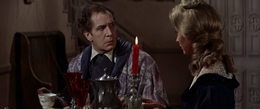 narrative kicking and screaming to an 80 minute running time. As with all horror anthologies, Tales of Terror has its highs and lows but makes for compelling viewing even during its weakest links. Furthermore, it also works as a fascinating rough draft for some ideas that would later be explored more fully in the Corman-Poe cycle. In the first and most traditional story, "Morella," Vincent Price portrays an embittered, alcoholic recluse who finally receives a visitor in the form of his estranged daughter, Lenora (Maggie Price), whom he blames for the death of his beautiful, egocentric wife, Morella. Lenora reveals that she only has a short time left to live, and she wants to see her father before shuffling off into the void. Gradually the father and daughter show signs of forgiveness, but the malefic spirit of Morella intervenes with tragic, fiery results.
narrative kicking and screaming to an 80 minute running time. As with all horror anthologies, Tales of Terror has its highs and lows but makes for compelling viewing even during its weakest links. Furthermore, it also works as a fascinating rough draft for some ideas that would later be explored more fully in the Corman-Poe cycle. In the first and most traditional story, "Morella," Vincent Price portrays an embittered, alcoholic recluse who finally receives a visitor in the form of his estranged daughter, Lenora (Maggie Price), whom he blames for the death of his beautiful, egocentric wife, Morella. Lenora reveals that she only has a short time left to live, and she wants to see her father before shuffling off into the void. Gradually the father and daughter show signs of forgiveness, but the malefic spirit of Morella intervenes with tragic, fiery results.
In "The Black Cat," a very loose spin on Poe's most graphic tale crossed with "The Cask of Amontillado," Peter Lorre is Montresor Herringbone, a drunken lout who spends his evenings at the tavern and ignores his wife, Annabel (Joyce Jameson, who later reprised the same basic role in Comedy of Terrors). One night Montresor engages in a humorous wine tasting contest with snobby connoisseur Fortunato (Price), which indirectly ignites an affair between Fortunato and Annabel. Naturally our sloshed antihero loses his mind and plots the perfect murder, but the family pet, a black cat, has other plans...
Finally, "The Facts in the Case of Mr. Valdemar" pairs up Price as a dying aristocrat with Basil Rathbone as Carmichael, an unscrupulous mesmerist who uses hypnotism to alleviate his patient's pain. Unfortunately Carmichael abuses his position and manipulates a promise from Valdemar that his wife, Helene (Debra Paget), will wed Carmichael after her husband's demise. Things take a turn for the worse when Valdemar's body dies during a hypnotic state, resulting 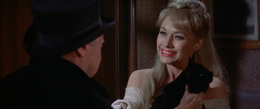 in horrific consequences for everyone involved.
in horrific consequences for everyone involved. 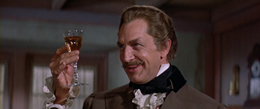
Despite the title, there isn't a whole lot to be terrified about in Tales of Terror. Rather, it's a compelling study in three different moods, with "The Black Cat" operating most successfully as a study in ghoulish humor. The silly tone would later dominate Corman's The Raven, but it already works like a charm here as an extended sketch. Lorre in particular dominates his every moment on film and proves to be a fine comedian, while his wine tasting scene with Price has justifiably become a fan favorite. (Note: for an amusing disorienting effect, try running Lorre's obligatory distorted nightmare sequence in 16x9 mode on a standard 4:3 television set.) "Morella" is beautifully filmed and highly atmospheric, but it's too brief and indifferently acted to rank up there with its obvious inspiration, House of Usher; however, its sense of tragic romance and avenging wife from the beyond the grave offer glimpses of the later The Tomb of Ligeia. "Valdemar" is basically a comic book treatment of a more serious story and, while somewhat strangely paced, benefits from a memorable gruesome finale which left a strong impression on more than a few matinee audiences. It all looks great as usual, with Floyd Crosby's adroit camerawork and Daniel Haller's inventive production design wringing every little visual detail out of the stories despite the low budget. Matheson wrote the screenplay again, which is literate enough but hard to separate from the other Corman scripts of the period.
MGM's DVD of Tales of Terror marked the second widescreen presentation of this film (following the laserdisc), which uses every inch of the Panavision frame and simply doesn't work at all in pan and scan. From the terrific animated segues with Price offering macabre bits of narration ("This is the heartbeat of a dying man...") to the simple payoff shot of "The Black Cat," you need to see the entire image just to understand what's happening before your eyes. The DVD is much brighter than the previous Orion/Image laserdisc (which was paired with the underrated The Premature Burial); this presentation reveals many new details in the sets and costumes but also removes a great deal of the shadowy textures in the process. The disc also includes the terrific theatrical trailer.
Not surprisingly, the Arrow Blu-ray leapfrogs over the DVD edition with a rich, very colorful HD transfer on par with the rest of the MGM catalog releases. The main extra here is The Directors: Roger Corman, an archival one-hour piece on his career created as part of a TV series originally released on VHS and DVD. Contributors like Ron Howard, Martin Scorsese, and James Cameron talk about getting their start under Corman at New World, and it's a fine primer on one of the great drive-in pioneers of all time. Then there's the peculiar but amusingly compelling "Cats in Horror Films," in which writer Anne Billson covers the history of feline fear from Poe through Stephen King adaptations. Then there's a 1993 short film adaptation of "The Black Cat' directed by The Bunker's Rob Green, which anticipates the later Stuart Gordon Masters of Horror version by planting Poe himself square in the middle of the story. Writer Kim Newman also contributes a video essay about Poe with a focus on his cinematic legacy, and the theatrical trailer is included as well. As with the other titles, the disc comes with reversible artwork, in this case 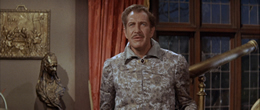 alternating between the poster art and a new design by Dan Mumford.
alternating between the poster art and a new design by Dan Mumford.
The following year, Corman and company 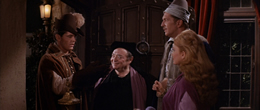 took a sharp left turn with The Raven, taking its title and a few lines of dialogue from Poe's most famous poem. Despite the cast and studio promotion, however, it's an all-out comic fantasy rather than a horror film with Poe and Lorre returning in high camp form respectively as Erasmus Craven, a powerful magician pining over his lost wife, and Bedlo, a slurring enchanter who pops up in Erasmus' study as a raven. Erasmus manages to break the spell and learns that dark magic is afoot under the command of their old foe, Dr. Scarabus (a deliciously evil Boris Karloff), who is keeping company with our hero's wife, Lenore (Hazel Court). Joined by Bedlo's clueless son, Rexford (a very young Jack Nicholson) and Craven's naive daughter, Estelle (Sturgess), they infiltrate the court of Scarabus and start a chain of events leading to a grand duel between the two most powerful sorcerers.
took a sharp left turn with The Raven, taking its title and a few lines of dialogue from Poe's most famous poem. Despite the cast and studio promotion, however, it's an all-out comic fantasy rather than a horror film with Poe and Lorre returning in high camp form respectively as Erasmus Craven, a powerful magician pining over his lost wife, and Bedlo, a slurring enchanter who pops up in Erasmus' study as a raven. Erasmus manages to break the spell and learns that dark magic is afoot under the command of their old foe, Dr. Scarabus (a deliciously evil Boris Karloff), who is keeping company with our hero's wife, Lenore (Hazel Court). Joined by Bedlo's clueless son, Rexford (a very young Jack Nicholson) and Craven's naive daughter, Estelle (Sturgess), they infiltrate the court of Scarabus and start a chain of events leading to a grand duel between the two most powerful sorcerers.
A fun little romp, The Raven features an even more elaborate, ornate look than its predecessors and mainly works as an opportunity to watch three old pros strut their stuff. Surprisingly, the very sexy Court manages to hold her own against them and makes a fine foil for Karloff, revealing comic chops unexplored in her previous Corman/Poe film, the Price-less The Premature Burial. Of course the real highlight here is that climactic showdown, an entire reel's worth of fantastic silliness with Price and Karloff flinging spells (and special effects) back and forth at each other in front of the rest of the cast. (Weirdly, Disney would stage a similar sequence the same year in The Sword in the Stone.) The usual suspects are still here behind the camera, of course, with Matheson contributing the witty screenplay and Les Baxter really cutting loose with the comic music from start to finish.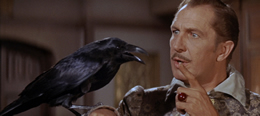
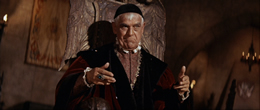
The home video course of this film follows its predecessors closely from Image laserdisc to MGM DVD to Blu-rays in both Price sets. The HD transfer from MGM is one of the strongest, correcting the overly bright previous DVD back to its original moody, baroque black levels and featuring some eye-popping shades of red and rusty brown in the production design. The Scream Factory disc (part of The Vincent Price Collection II) sports the usual PBS Price intro and outro, the DVD's "Richard Matheson: Storyteller" featurette with the late scribe reminiscing about the film, audio from the promotional LP for the film, the theatrical trailer, a still gallery, and "Corman's Comedy of Poe," with the director happily chatting about assembling his dream cast and letting them go to town in front of the camera. The Arrow version features the Matheson and Corman featurettes, LP record, and trailer while adding a great 1984 documentary about Lorre, "Peter Lore: The Double Face," an overview of the actor's life and career (apparently never available with English subtitles before). There's also another Rob Green short film, "The Trick," with two wizards battling it out in an obvious homage to this film.
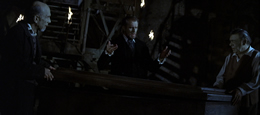 Since the Poe connection was already pretty tenuous by this point, it made sense for Corman and Price to expand their horizons a bit with a new author. They chose the
Since the Poe connection was already pretty tenuous by this point, it made sense for Corman and Price to expand their horizons a bit with a new author. They chose the 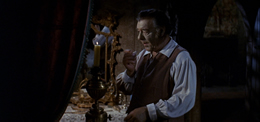 most logical one, H.P. Lovecraft, for their next collaboration, an adaptation of the short story "The Case of Charles Dexter Ward"... but AIP was having none of that and decided to pass it off as another Poe film by calling it The Haunted Palace, with Price reciting a few lines from the titular Poe poem. (The same trick was later pulled even more ridiculously with Witchfinder General, which turned into the faux-Poe Conqueror Worm.) Regardless of the source, it's a really terrific horror film with some of the creepiest atmosphere of any film from that decade and a particularly strong, sinister turn by Price in dual roles as Charles Dexter Ward, a good guy who moves back to his ancestral home, and the evil necromancer Joseph Curwen, who is seen being burned at the stake in the opening scene and who seems to be exerting a supernatural influence over his descendant. Charles's wife, Ann (Paget again, turning in a very fine performance), is unnerved by the transformation in her husband's behavior, while the denizens of the local town of Arkham (including a creepy Lon Chaney, Jr.) are either horribly mutated or very ominous in their behavior. Not surprisingly, it all turns out to be connected to the Elder Ones and that pesky book, the Necronomicon, which still exerts a powerful influence over the living.
most logical one, H.P. Lovecraft, for their next collaboration, an adaptation of the short story "The Case of Charles Dexter Ward"... but AIP was having none of that and decided to pass it off as another Poe film by calling it The Haunted Palace, with Price reciting a few lines from the titular Poe poem. (The same trick was later pulled even more ridiculously with Witchfinder General, which turned into the faux-Poe Conqueror Worm.) Regardless of the source, it's a really terrific horror film with some of the creepiest atmosphere of any film from that decade and a particularly strong, sinister turn by Price in dual roles as Charles Dexter Ward, a good guy who moves back to his ancestral home, and the evil necromancer Joseph Curwen, who is seen being burned at the stake in the opening scene and who seems to be exerting a supernatural influence over his descendant. Charles's wife, Ann (Paget again, turning in a very fine performance), is unnerved by the transformation in her husband's behavior, while the denizens of the local town of Arkham (including a creepy Lon Chaney, Jr.) are either horribly mutated or very ominous in their behavior. Not surprisingly, it all turns out to be connected to the Elder Ones and that pesky book, the Necronomicon, which still exerts a powerful influence over the living.
This film was one of the last Corman/Price efforts to appear on home video for some reason, persistently refusing to turn up on VHS or TV for many years. Fortunately it's been pretty smooth sailing ever since courtesy of the usual laser/DVD route and the Blu-ray editions, with an earlier no-frills HD rendition from Germany also popping up to confuse things a bit. The HD transfer looks great but exposes a few oddities in the production, such as using textured 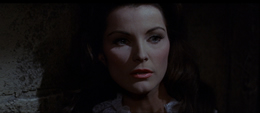 cloth over the lens in a few scenes and easily being mistaken for an encoding issue (especially the signature foggy arrival scene with all the grotesque townspeople). Also noteworthy is the exceptional music score by Ronald Stein, returning from his memorable gig on The Premature Burial; it's easily the most memorable and effective musical accompaniment out of the entire series.
cloth over the lens in a few scenes and easily being mistaken for an encoding issue (especially the signature foggy arrival scene with all the grotesque townspeople). Also noteworthy is the exceptional music score by Ronald Stein, returning from his memorable gig on The Premature Burial; it's easily the most memorable and effective musical accompaniment out of the entire series.
The Scream Factory disc contains another Price video wraparound as well as a new Williams audio commentary, a fine companion piece to her earlier one as it explores the midpoint of the Corman/Price run. The trailer and a brief but solid Corman interview from the DVD are also ported over, while horror expert Tom Weaver (a familiar name to DVD buffs) contributes the interesting "A Change of Poe" interview about the film's odd authorial history. On the other hand, the Arrow disc features a completely different audio commentary with Price pal David Del Valle and Derek Botelho covering the rapport of the notable actors on the set and the state of their careers at the time, while Kim Newman appears for a featurette on the truly odd history of Lovecraft on film, with his very difficult subject matter often resulting in some truly bizarre writing solutions. The Corman interview and trailer are present here as well along with a poster and stills gallery.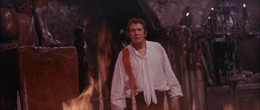
While the Arrow box doesn't contain Masque of the Red Death (the sole missing Price/Poe title here, and it's in the first Scream Factory set), it does have the final and most divisive of the series, 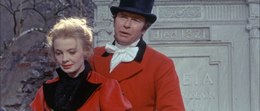 The Tomb of Ligeia. Penned by Oscar-winning Chinatown scribe Robert Towne, it was shot in England like Masque and made the drastic shift to filming numerous scenes in exteriors in broad daylight. It also reveals Corman's increasing shift away from traditional horror material as it mostly plays like a peculiar romantic fantasy for most of the running time, at least until the obligatory spectral villain and fiery climax arrive to wrap things up.
The Tomb of Ligeia. Penned by Oscar-winning Chinatown scribe Robert Towne, it was shot in England like Masque and made the drastic shift to filming numerous scenes in exteriors in broad daylight. It also reveals Corman's increasing shift away from traditional horror material as it mostly plays like a peculiar romantic fantasy for most of the running time, at least until the obligatory spectral villain and fiery climax arrive to wrap things up.
Once again Price dons an odd pair of spectacles to play an eccentric aristocrat, in this case Verden Fell, whose dead wife Ligeia doesn't seem to want to rest quietly (obvious since her eyes reflexively pop open during her funeral in the pre-credits sequence) and appears to have some sort of supernatural link to the stray black cat prowling the premises. During a fox hunt, Fell meets and begins a romance with the Lady Rowena Trevanion (Shepherd, who went on to get her eyes pecked out in Damien: Omen II). Despite some of Fell's peculiarities (like pelting the cat with cabbage, the source of the film's loopiest line of dialogue), the two decide to get married... but Ligeia's continued presence proves to be more than a slight marital complication.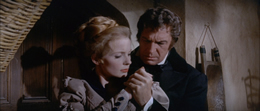
While this is absolutely not the film to spring on someone as an introduction to the series, it's a gorgeous, haunting piece of work buoyed by very strong performances by both Price and Shepherd. The decaying English buildings give the film a markedly different flavor compared to the preceding set-bound entries, and the spacious scope cinematography by Hammer vet Arthur Grant results in some delightfully unexpected imagery, most notably one of Corman's trademark dream sequences with a few new wrinkles of its own.
The Tomb of Ligeia has the distinction of being one of the first films to ever have an audio commentary recorded for it, though that exact terminology didn't exist at the time when David Del Valle sat down with Shepherd to record her thoughts when they watched the movie together. That track made its way to the film's debut on laserdisc and resurfaced again on the MGM DVD, both of which sported an adequate but problematically soft transfer from damaged elements. That disc also featured a second commentary with Corman (who goes into great detail about the film's many aesthetic shifts) and the trailer, while the An Evening with Edgar Allan Poe Price special was included on the flipper disc's other side. Even the film's eventual appearance on MGM HD wasn't any great shakes, still looking very fuzzy and worn. Fortunately it fares far better on the Blu-ray editions, which are easily the best the film has ever looked on home video. There's still more print damage than the other titles, but the detail level and color fidelity is far more satisfying with a more effective reproduction of the film's delicate hues as seen in 35mm prints. The Scream Factory disc features the Corman commentary, the trailer, and more Price bookends, plus a still gallery, but in an interesting new twist, there's a new, entirely different audio commentary with Shepherd. Featuring more professional sound recording (this is quite a few years later after all), it covers some of the same territory and makes for an interesting companion piece to the older one.
The original Shepherd commentary can be found on the Arrow disc, which also ports over the Corman commentary and, in a nice touch, features an isolated music and effects track for the lovely, still-unreleased score by Kenneth V. Jones (a bonus present on all of the other titles as well except for Usher). The composer also pops up for a solid video interview as part of a selection of crew featurettes along with assistant director David Tringham, clapper loader Bob Jordan, and co-screenwriter (and uncredited producer's assistant) Paul Mayersberg, with territory covered including the writing process with Towne, the English production schedules adjusting to Corman's needs, and the integration of Price with the British cast. Needless to say, any fans of Price, Poe, or good solid horror filmmaking will find many, many hours of bliss here.
Reviewed on December 11, 2014.























